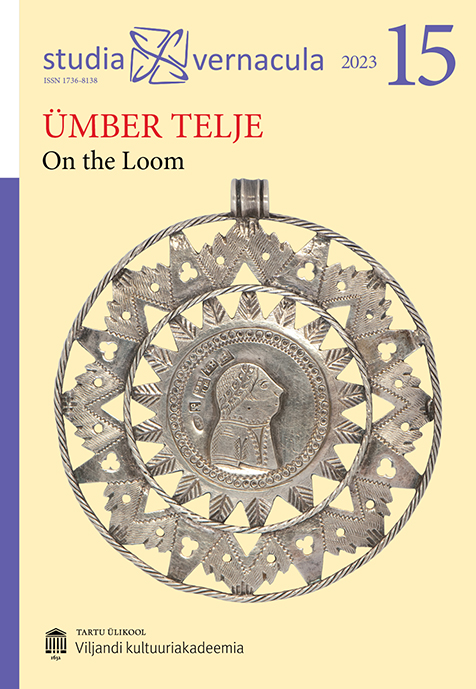Mineviku kogemust uurides. Rüiteki näide / Studying past experience. The case of rüi blanket
DOI:
https://doi.org/10.12697/sv.2023.15.182-195Abstract
This article examines the unique type of blanket used in Hiiumaa, the rüi. Presumably the rüi blanket is related to the Swedish and West Finnish fringed rugs woven with the ryijy technique on looms. In contrast to the ryijy technique, the Hiiumaa rüi does not have yarn piles sown into it, but the hairy top layer is made of rug rags (nukud) sown onto the base blanket. According to archival records, the rüi imitated fur, which made the blanket exceptionally warm and could be worn at night in cold conditions (e.g. on a sea voyage, sleeping in a meadow). In Hiiumaa, rüis were still made until the turn of the 19th and 20th centuries, when the continuity of blanket making ceased. The aim of this article is to present the historical background of the rüi blanket, to describe the process of making of a rüi blanket reconstruction, and to compile stories of experiences from people who slept under the rüi reconstruction.
Although this type of blanket was still very common in Hiiumaa in the 19th century, only two exemplary blankets are known to have survived to the present day. A rüi of rather poor condition is preserved in the Estonian National Museum (ERM A 332: 4). During a collection expedition to Hiiumaa in 1901, the Finnish ethnologist Axel Olai Heikel (1851–1924) brought one of the rüis also to the Finnish National Museum (SU 4002: 269). In addition to the few specimens, many written records have fortunately survived from
the beginning of the 20th century of how the rüi was made and used. Most of the written records are preserved in the Ethnographic Archive (EA) and Correspondents’ Reply (KV) of the Estonian National Museum.
Rüi blankets have been used in different places in Hiiumaa, but they had one purpose – to protect against cold. The blanket was taken to the meadows (it was used to sleep under a hayloft), and it was also used as a boat blanket, although the rüi was mainly used to sleep under at home during the cold season, as just a blanket was rarely warm (ERMA EA 20: 1, 193). In addition to its very practical properties, the rüi also had a wider social significance, as it was part of the dowry of a Hiiumaa bride. Communal work bees were organised to make the blanket and even in the 19th century, the gifts brought to the bride still included clothes suitable for making shreds (nukud).
A recurring theme throughout the period of reconstruction was the weight of the rüi blanket. It has been noted that the blanket was so heavy that a sick man could not even carry it and that children grew tired under it. It is recorded from Pühalepa that the blanket could have weighed up to one pood (16,381 kg). In addition, I wanted to add value to the reconstructed blanket through stories of experience. Very many ethnographic descriptions leave the impression that the rüi was very heavy and unusually warm. My desire was to find out how people in the 21st century reflect the experience of sleeping under a blanket that was common in the 19th century. Does it get cold, does the blanket prickle, is it too heavy, etc.?
In its finished form, the rüi reconstruction weighs 8,1 kg, half the target weight. The rüi blanket deposited in Finland weighs 7 kg (+/– 1 kg), which calls into question the veracity of the archival record rather than the physical shortcomings of the reconstruction.
Three men slept under the rüi reconstruction between 7–13 September 2021, when the night-time temperature was around +10ºC. The participants of the experiment pointed out that the blanket absorbed moisture very well and they didn’t get wet even when sleeping on the ground. The people sleeping under the rüi did not mention that the blanket was too heavy or too warm.
Through the process of studying and making a rüi, a significant number of people took part in the intangible heritage of the Hiiumaa people – their skills, knowledge, and experience. The finished blanket is part of the collections of Hiiumaa Museums (HKM 6648:1 Tst 8:22), thus providing an opportunity to familiarise oneself with the item and use the information also for future generations.
Keywords: sea blanket, rüi, handicraft techniques, reconstruction, practice-based research, user experience

